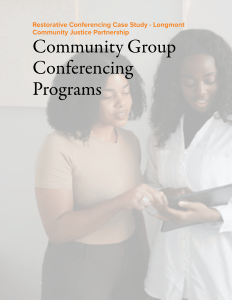Community Solutions to Justice: Solutions for Faster, Fairer, and More Effective Justice in American Communities
In communities across the country, America’s courts are struggling to deliver on their promise of speedy, fair, and effective justice. In this groundbreaking report, we explore community solutions to justice and whether they can help community leaders provide faster, fairer, and more effective justice for their communities.
Download the Full Report
Across the country, America’s courts are struggling to deliver on the principle of speedy, fair, and effective justice. Victims and the accused regularly wait hundreds of days to have their cases heard in court. Less than half of those involved in the courts describe the process as fair. Nearly half, 44% of all those convicted of a crime will reoffend within one year, giving the United States the highest recividism rate in the world.
While many reforms have been proposed and advanced to address these issues, in this groundbreaking report, we present one approach that has, as of yet, been little examined. Community solutions to justice.
Download Individual Solutions with Case Studies
Solution #1: Arbitration
Arbitration is the oldest community solution to justice in the United States, but little utilized in the community today. While Native Americans used arbitration to settle disputes between neighboring tribes, it did not catch on with early American colonists until travelers from Europe brought the practice, already used heavily in maritime trade, to the colonies. Total case numbers are difficult to obtain, our research indicates that there are at least 7 community arbitration programs active today, which arbitrate around 300 cases per year.
Solution #2: Community Mediation
Community mediation is the most widespread, and potentially the most promising, solution to delivering speedy, fair, and effective justice outside of traditional court processes. Created out of two separate movements in the 1960s, one to tackle the widespread inefficiencies and delays already present in the court system, and the other to moderate the rising urban violence that arose in the heat of the civil rights movement. Today, estimated 400 community mediation centers now mediate over 400,000 cases per year in the United States.
Solution #3: Restorative Conferencing
Conferencing represents a promising solution for more serious crimes than community mediation usually addresses, and is often shown to reduce recidivism, primarily for youth offenders.
Use of conferencing in the United States today is likely still widespread. We were able to identify 32 active restorative conferencing programs in 19 states, with an estimated annual caseload of 2,500-3,200.
Solution #4: Victim-Offender Dialogue
Victim-offender dialogues (VODs) are used almost exclusively for criminal cases, and in many cases replace a standard criminal trial. First started in 1974 by two youth probation volunteers in Canada, around a dozen programs serve nearly 1000 cases per year in the United States.
Solution #5: Teen Court
Teen court is a “peer justice” diversion program. It operates much like a traditional juvenile court, however unlike a traditional juvenile court, other teens serve as the court clerks, bailiffs, attorneys, jurors, and sometimes as judges. We were able to identify 16 community teen court programs in 8 states, though teen courts are likely far more widespread than that.
Download Individual Case Studies
Dispute Resolution Center of Thurston County
Program: Community Mediation Program
Solution: #2 Community Mediation
NY Peace Institute
Program: Small Claims Presumptive Mediation Program
Solution: #2 Community Mediation
Longmont Community Justice Partnership
Program: Community Group Conferencing (CGC), RESTORE
Solution: #3 Restorative Conferencing
Restorative Justice Mediation Program
Program: Victim-Offender Dialogue Program
Solution: #4 Victim-Offender Dialogue











